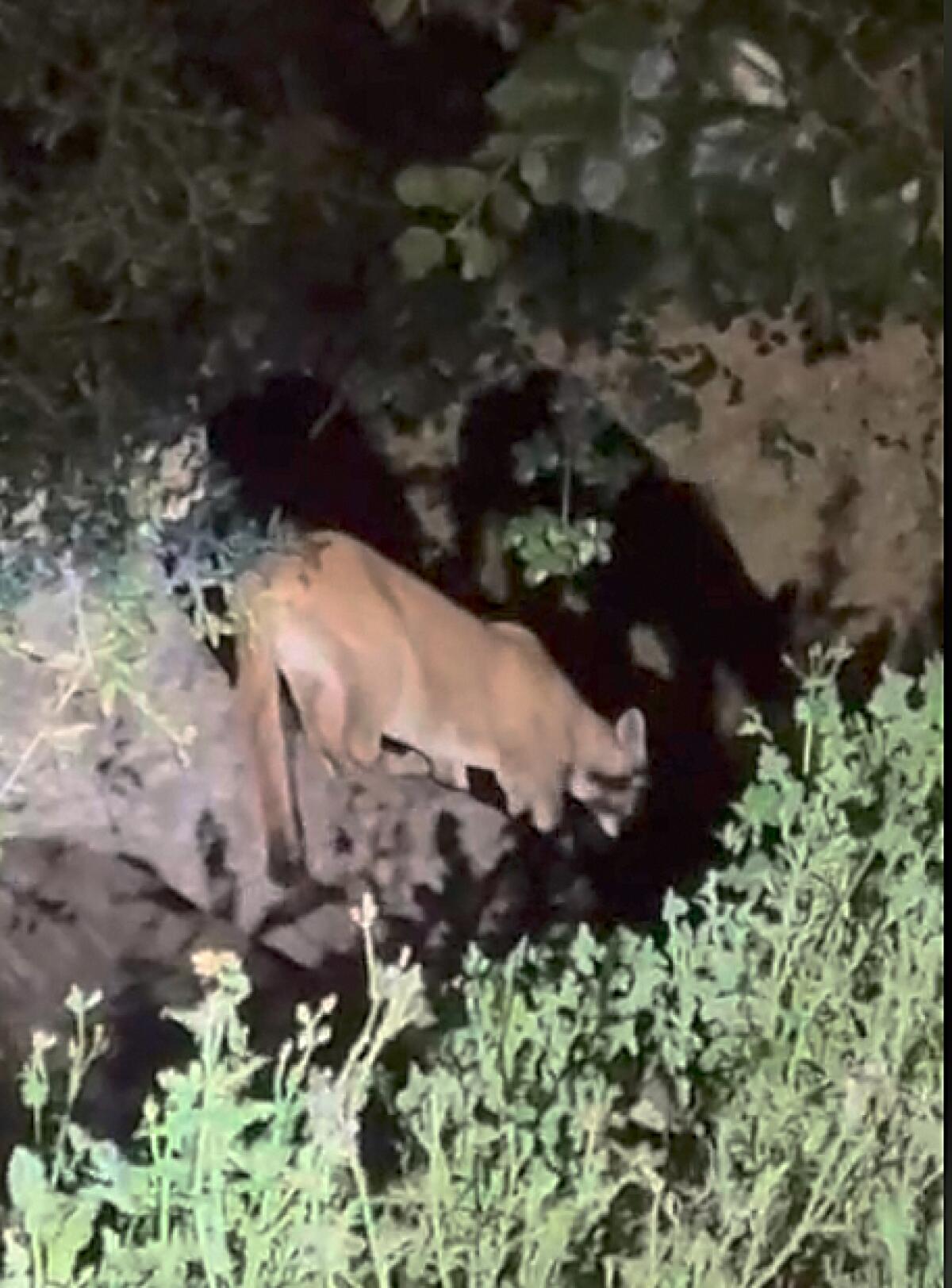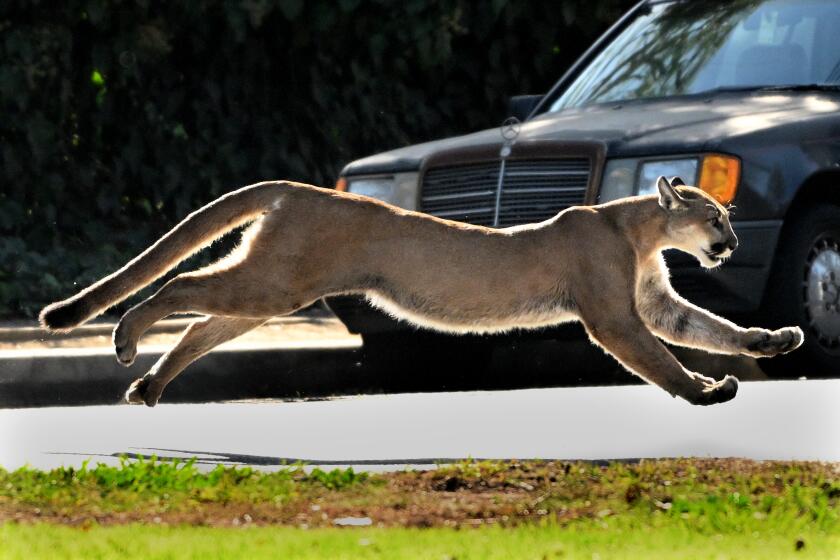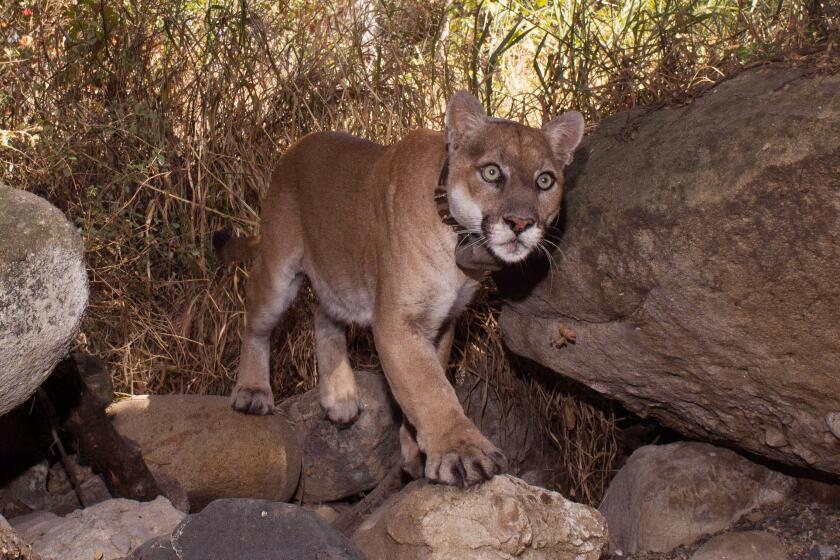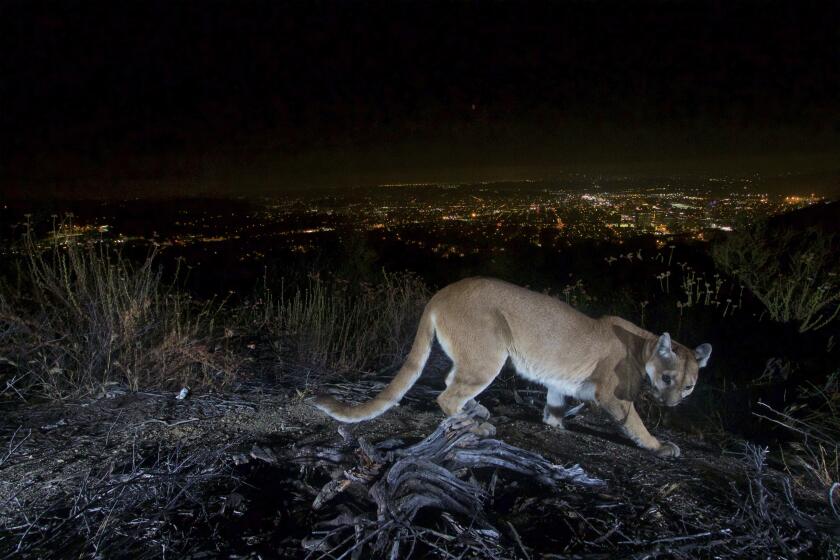Looks like there’s a new mountain lion in Griffith Park. Let’s try not to kill him

- Share via
There was no doubt about it. The hulking blond furry animal on a tree trunk illuminated by the headlights of a car in a parking lot east of Barham Boulevard on the edge of Griffith Park last week was a mountain lion.
Seriously? In Los Angeles, the beloved mountain lion named P-22 had lived for a decade in Griffith Park. But he was an aberration. It was astonishing that he got there in the first place — most likely crossing dangerous freeways to get to the park, cramped by lion standards, where he easily found prey such as deer and just as easily avoided the people who flocked there for recreation.
He was captured and euthanized in late 2022 due to sickness and severe injuries.
The National Park Service, which has reviewed video footage of the sighting, is taking the claim seriously, according to spokesperson Ana Beatriz Cholo.
But here was video, shot by a resident of the adjacent apartment complex. It was as if the camera had captured the ghost of L.A.’s most famous cat.
All I could think was: Don’t move! Stay! Better yet, back away from the parking lot! A leading cause of death for urban pumas is being hit by a vehicle. And in the video, he is also seen walking hesitantly on the grassy side of the parking spaces. (A wildlife biologist says the cat in the video is most likely male, so I’m going with “he.”)
It would be safer for the cat to tuck himself into the trees and grassy space of the park — and wait for the National Park Service biologists to find and tranquilize him to take biological samples for genetics testing and slip a GPS collar onto his neck so we can remotely roam with him.
If mountain lions can’t cross a road to find mates and territory without risking their lives, that’s an eventual death sentence for the local population.
And they’re definitely interested in adding this cat to the study of mountain lions in the Santa Monica Mountains (including Griffith Park), Simi Hills and Santa Susana Mountains that the agency has been doing for more than two decades.
Jeff Sikich, a biologist on the study, says the video suggests the cat is a young adult and probably male based on the broadness of the shoulders, the musculature and a glimpse of genitalia. It is the first legitimate evidence he has seen of a mountain lion in Griffith Park since P-22 died.
How did he get there? If he came from the far western mountains — P-22 is thought to have been born in the Simi Hills — he crossed the 405 and 101 freeways. If he came from the Verdugo Mountains northeast of Griffith Park, he most likely crossed the 5 and 134 freeways. There are some paths and culverts under various freeways, and overpasses he might have found. “Regardless, it’s a tough trek,” Sikich says of the journey to Griffith Park.
Celebrity is far too shallow a gloss on P-22. What made this mountain lion essential was not that he was famous, but that he persevered.
Will he stay? Male mountain lions, territorial and looking for mates, have huge home ranges, averaging 150 square miles, says Sikich. The cat who would be collared and numbered P-22 was about 2 or 3 years old when Sikich captured him in Griffith Park in 2012. The park is a puny nine square miles and offered P-22 no mating opportunities. But it was all his.
Vehicle strikes and rat poison are two of the biggest dangers this cat will face no matter where he decides to live in the Los Angeles area. P-22 was probably hit by a car shortly before he was euthanized. And blood tests later showed he had two rodenticides in his system when he died. Earlier in his life, scientists treated him for mange, which is generally a result of rat poison.
A bill awaiting Gov. Gavin Newsom’s signature could take off the market one of the most commonly used rat poisons that are ingested by raptors, mountain lions, bobcats and other wildlife.
For years, the state of California has been trying to curtail the use of various rat poisons that often sicken and kill wildlife and pets who eat prey that have ingested it. Assembly Bill 2552, the Poison-Free Wildlife Act, would expand a ban on rodenticides. The Legislature should pass it.
To make navigating roads and freeways less treacherous, we need more crossings. The Annenberg Wildlife Crossing over the 101 Freeway is under construction now. And the Safe Roads and Wildlife Protection Act, passed in 2022, requires the California Department of Transportation to construct crossings where they are needed when it builds new highways and improves existing ones. With less poison out there and more wildlife crossings, maybe this mountain lion will have a better chance.
From mountain lions to feral cats and palm trees to live-forevers, Craig Stanford’s “Unnatural Habitat” considers Southern California’s native and exotic flora and fauna.
Sikich won’t say when or how he will go looking for the park’s newest puma. And hopefully the cat is still there. People are so fascinated by the lions that they will follow the researchers. “I try to stay as elusive as the animals I’m catching,” he says, chuckling.
If he is collared, he will be the 121st cat to be added to the research study. But wouldn’t it be cool to skip that number and go straight to P-122? Some of the Park Service folks, including Sikich, think so.
Why not? It doesn’t subvert the research. It’s just a bit of a reminder for all of us that if we want to continue the legacy of P-22, the best way to do that is to make urban California a little less dangerous for its native cats.
More to Read
A cure for the common opinion
Get thought-provoking perspectives with our weekly newsletter.
You may occasionally receive promotional content from the Los Angeles Times.















